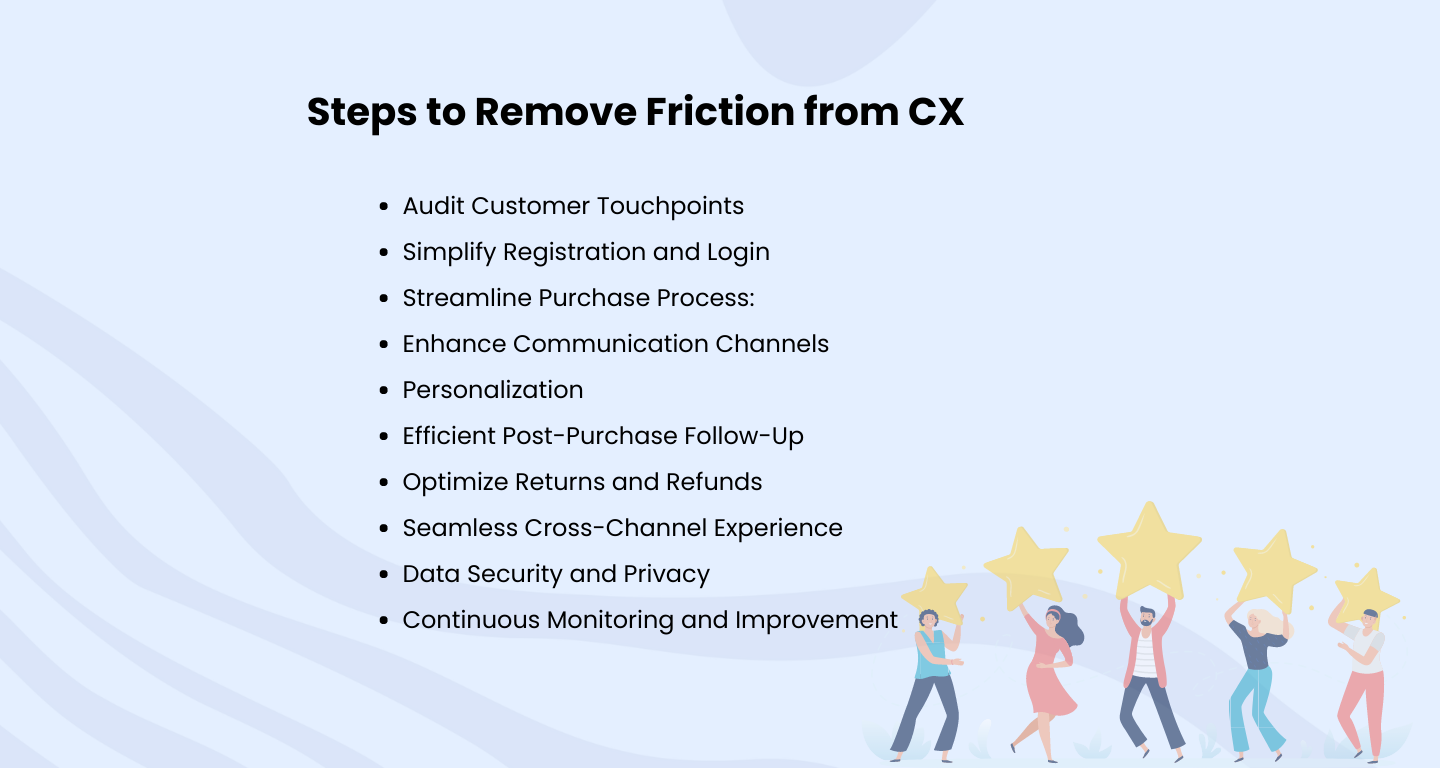Customer Experience
Frictionless Customer Experience: Unlocking Seamless Connections for Your Business
Article written by Kate Williams
Content Marketer at SurveySparrow
11 min read
19 September 2025

Have you ever wondered what makes some businesses effortlessly stand out, captivating their customers at every touchpoint, while others struggle to keep up? The answer lies in the concept of a frictionless customer experience. Imagine a world where your interactions with a company are seamless, intuitive, and devoid of any unnecessary hurdles. This is the hallmark of a truly remarkable customer journey.
In this blog, we’ll look into the essence of frictionless experience, understand its significance, and learn the steps to achieve it. Let’s delve into the heart of customer-centricity and discover how your business can soar to new heights.
What Does a Frictionless Customer Experience Mean?
At its core, a frictionless customer experience refers to the seamless, hassle-free interactions a customer has with a brand throughout their journey. It’s the art of eliminating unnecessary barriers and making every step—from initial engagement to post-purchase support—feel effortless. Just imagine visiting a website where navigation is intuitive, finding information is a breeze, and purchasing is as simple as a single click. That’s the essence of a frictionless experience.
Read More: Customer Experience Best Practices: 10 Tips to Improve CX Today
Key Elements
1. User-Centric Design
- A frictionless customer experience revolves around designing every touchpoint with the customer in mind. User-centric design principles ensure that websites, apps, and other platforms are intuitive, easy to navigate, and visually appealing.
- This design approach anticipates user needs, reducing the effort required to find information and complete actions.
2. Simplified Processes
- Streamlining processes is a key aspect of frictionless customer experiences. This involves eliminating unnecessary steps, reducing form fields, and minimizing data entry requirements during transactions or sign-ups.
- The goal is to make the entire process efficient and straightforward.
3. Personalization and Recommendations
- By leveraging data analytics and AI, brands can personalize the customer journey. They can offer tailored product recommendations, content, and solutions based on a customer’s preferences and behaviors.
- This not only saves customers time by presenting relevant options but also enhances their overall experience.
4. Omnichannel Consistency
- A frictionless experience should seamlessly transition across different channels. Whether a customer interacts with a brand through a website, mobile app, social media, or in-store, the experience should remain consistent.
- This requires cohesive design, messaging, and access to customer data across all touchpoints.
5. Effortless Support and Assistance
- Quick and effective customer support is vital for a frictionless experience. Brands should offer various avenues for customers to seek assistance, such as live chat, chatbots, email, and phone support and provide clear guidance on common issues, such as how to uninstall Google Drive from Mac.
- The goal is to provide prompt and accurate solutions to any issues that may arise.
6. Transparent Communication
- Open and transparent communication builds trust and contributes to a frictionless experience. Brands should provide clear and concise information about products, pricing, shipping, and return policies.
- Hidden fees or confusing terms can introduce unnecessary friction.
7. Mobile Optimization
- With the rise of mobile usage, ensuring a frictionless experience on smartphones and tablets is crucial.
- Responsive design, fast loading times, and mobile-friendly interfaces are essential for delivering a seamless experience to customers on the go.
8. Seamless Payment and Checkout
- Simplifying the payment process is a cornerstone of frictionless customer experiences.
- Secure and convenient payment options, saved payment information, and guest checkout options can all contribute to smoother transactions.
9. Feedback and Continuous Improvement
- Brands should actively seek customer feedback to identify pain points and areas for improvement.
- Regularly iterating on the customer experience based on this feedback can lead to ongoing refinement and a consistently better journey for customers.
- You can consider SurveySparrow for this. The advanced features allow you to create, share, collate and analyze customer data effortlessly. Moreover, the conversational surveys ensure improved response rates.
14-day free trial • Cancel Anytime • No Credit Card Required • No Strings Attached
10. Data Security and Privacy
- Maintaining the security of customer data and respecting privacy concerns is paramount.
- Brands that prioritize data protection and communicate their security measures effectively can help customers feel more at ease during their interactions
What Does Frictionless Mean in Business?
The term frictionless, in business takes on a broader meaning. It encompasses the streamlining of processes, workflows, and communication to create a smoother operational environment. When businesses operate with reduced friction, they become agile, responsive, and capable of delivering exceptional value to both customers and stakeholders.
For instance, the adoption of collaborative tools like Slack or Microsoft Teams can transform the way teams communicate, share ideas, and work together. This digital evolution reduces friction in communication and boosts productivity across the organization.
What Causes Friction in the Customer Experience?
Friction in the customer experience can arise from various sources, and identifying these pain points is crucial for effective resolution. Common culprits include complex user interfaces, lengthy and confusing forms, a lack of personalization, and inadequate customer support. By pinpointing these sources of friction, businesses can devise targeted strategies to address them head-on.
A classic example is the frustration customers feel when they have to navigate through a labyrinth of automated phone menu options before reaching a human customer service representative. This unnecessary detour creates friction and erodes the overall experience.
Let’s look at the causes in detail-
1. Complex User Interfaces (UI) and Navigation:
Complicated website layouts or mobile app interfaces can confuse customers and make it difficult for them to find what they need. If users struggle to locate products, information, or services, they may become frustrated and abandon their interactions.
2. Lengthy and Confusing Forms:
Forms that require excessive information or present confusing fields can lead to friction. Customers may abandon transactions or registrations if they perceive the process as time-consuming or unclear.
3. Lack of Personalization:
Customers expect brands to understand their preferences and tailor experiences accordingly. When interactions lack personalization—such as generic recommendations or irrelevant content—it can lead to disengagement and frustration.
4. Inadequate Customer Support:
Slow response times, unhelpful responses, or difficulty in reaching customer support agents can create negative experiences. Customers who encounter roadblocks when seeking assistance may feel unsupported and dissatisfied.
5. Unintuitive Payment Processes:
If the payment process is confusing, lacks transparency, or presents unexpected charges, customers may hesitate to complete transactions. A lack of payment options or security concerns can also contribute to friction.
6. Inconsistent Cross-Channel Experience:
When customers experience disparities in the brand experience across different channels (website, app, social media, and in-store), it can lead to confusion and frustration. Brands should ensure a seamless transition and consistent messaging across all touchpoints.
7. Slow Loading Times:
Slow website or app loading times can test a customer’s patience. Today, customers expect quick access to information and services. Delays can lead to abandonment.
8. Lack of Clarity in Policies:
Unclear or complicated terms and conditions, shipping policies, and return processes can lead to uncertainty and friction. Hidden fees or unexpected rules can create a sense of distrust.
Why Should You Remove Friction from Customer Experience?
The answer is simple: to foster loyalty and drive business growth. Customers are more likely to remain loyal to a brand that consistently provides smooth, enjoyable interactions. A frictionless customer experience enhances customer satisfaction, reduces churn, and compels customers to become advocates for your brand.
According to a study companies with a strong focus on customer experience outperformed the S&P 500 index by nearly 80%. This statistic underscores the financial impact of prioritizing frictionless experiences.
Again, why is it important?
The importance of a frictionless customer experience cannot be overstated. Today, when options abound and attention spans are fleeting, businesses must seize every opportunity to captivate and retain their audience. A frictionless experience not only differentiates your brand but also cultivates lasting emotional connections with your customers.
Consider Apple’s seamless integration of its products and services. From iPhones to MacBooks to iCloud, Apple creates an ecosystem that minimizes friction between devices, ensuring a cohesive user experience.
Steps to Remove Friction from Customer Experience
Achieving a frictionless customer experience requires a strategic approach. Here’s a roadmap to guide you on your journey toward creating seamless interactions:

#1 Audit Customer Touchpoints
- Website Navigation: Analyze your website’s user interface (UI) and user experience (UX) to ensure intuitive navigation. Optimize menus, search functionality, and page load times.
- Mobile Responsiveness: Ensure your website is mobile-friendly and responsive across various devices and screen sizes for a seamless experience.
#2 Simplify Registration and Login
- Single Sign-On (SSO): Implement SSO to allow customers to access multiple services with a single set of login credentials.
- Social Login: Provide the option for users to log in using their social media accounts, eliminating the need for them to create new usernames and passwords.
#3 Streamline Purchase Process
- Guest Checkout: Allow customers to make purchases without creating an account. Offer guest checkout as a quick option.
- One-Click Purchase: Implement one-click purchasing options for returning customers, minimizing steps to complete a purchase.
#4 Enhance Communication Channels
- Multi-channel Support: Offer customer support through various channels like live chat, email, phone, and social media to cater to different preferences.
- Chatbots and AI: Implement AI-powered chatbots to provide instant responses to common queries and reduce waiting times.
#5 Personalization
- Tailored Recommendations: Use customer data to provide personalized product recommendations based on their preferences and browsing history.
- Customized Content: Deliver relevant content and offers to customers based on their interests and behavior.
#6 Efficient Post-Purchase Follow-Up
- Order Tracking: Provide real-time order tracking and status updates, so customers know the progress of their purchases.
- Feedback Loop: Encourage customers to provide feedback and reviews, and take action on their suggestions to improve the overall experience.
#7 Optimize Returns and Refunds
- Clear Policies: Ensure your return and refund policies are easy to understand and prominently displayed on your website.
- Automated Process: Streamline the returns process with automated labels and instructions, reducing customer effort.
#8 Seamless Cross-Channel Experience
- Omnichannel Integration: Maintain consistent customer information and purchase history across all channels to avoid redundancy and confusion.
#9 Data Security and Privacy
- Secure Payment: Implement secure payment gateways and reassure customers that their payment information is safe.
- Transparency: Clearly communicate your data usage and privacy policies to build trust with customers.
#10 Continuous Monitoring and Improvement
- Data Analysis: Regularly analyze customer data, feedback, and journey analytics to identify pain points and areas for improvement.
- Iterative Enhancements: Use A/B testing and iterative design to gradually refine the customer experience over time.
What Does Frictionless Mean in Marketing?
In marketing, a frictionless approach revolves around creating seamless and captivating campaigns that guide customers effortlessly through the buying journey. It’s about delivering the right message at the right time through the right channels, ensuring that every interaction resonates and contributes to a cohesive narrative.
Take the case of Spotify’s personalized playlists. By curating music selections based on individual preferences, Spotify reduces the friction of searching for the perfect song and enhances the user’s enjoyment of the platform.
Wrap Up!
As customer expectations surge, the concept of frictionless customer experience has emerged as a critical differentiator. This journey towards seamlessness isn’t just about convenience; it’s about nurturing lasting connections with your audience. By simplifying interactions, streamlining processes, and focusing on personalization, you can elevate your brand from being a mere option to becoming a preferred choice. And, before you leave, why not give SurveySparrow a try. Its free!
14-day free trial • Cancel Anytime • No Credit Card Required • No Strings Attached

Make your customers feel heard. Turn feedback into loyalty with SurveySparrow's CX platform.
Kate Williams
Related Articles

Customer Experience
Top 11 Customer Experience Management Tools & Platforms
19 MINUTES
24 July 2023

Customer Experience
7 Ways You Can Enhance Customer Experience. Keep That Habit Going!
13 MINUTES
30 August 2018

Customer Experience
Who is a Customer Experience Specialist? The Secret to Exceptional CX
8 MINUTES
30 June 2023

Customer Experience
Delving into CX Measurement Strategy : An Interview with Ian Golding
13 MINUTES
23 November 2019
